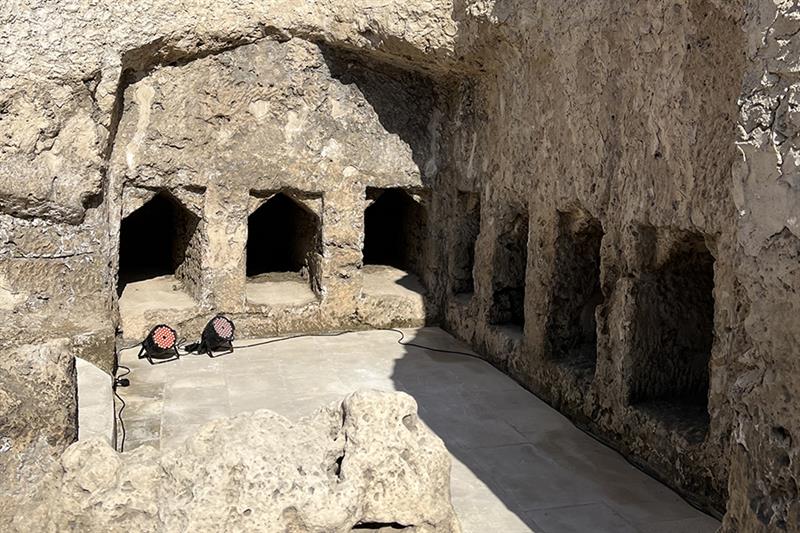Inauguration of Al-Shatby Necropolis
Nevine El-Aref , Tuesday 9 May 2023
Al-Shatby Necropolis in Alexandria has been officially inaugurated after three years of conservation work, reports Nevine El-Aref

In the heart of the modern city of Alexandria, a few hundred metres east of the Bibliotheca Alexandrina, is the Al-Shatby Necropolis, the most ancient necropolis in Alexandria, dating back to the third century BCE.
Although undecorated, its architecture is of great interest because it shows the development of Alexandrian tombs from modest shaft graves through gallery tombs to monumental hypogea.
The Alexandrian hypogeum consisted of a group of underground chambers cut into the bedrock around an open court where funerary rituals were conducted. Some chambers featured bed-shaped sarcophagi called kline, but most contain loculi, rectangular burial niches carved into the walls.
Many burials consisted of a niche housing an urn containing the remains of the deceased after cremation.
On Monday, the restored Al-Shatby Necropolis was inaugurated by Deputy Minister of Tourism and Antiquities for Tourism Affairs Ghada Shalabi, Secretary-General of the Supreme Council of Antiquities (SCA) Mustafa Waziri, Deputy of the Alexandria Governor Jackline Azer, and Mona Haggag, professor of archaeology at Alexandria University and head of the Archaeological Society of Alexandria, along with top officials from both the SCA and the governorate.
The Al-Shatby Necropolis, discovered at the beginning of the 20th century by Evaristo Breccia, third General Secretary of the Archaeological Society of Alexandria, consists today of the ruins of a hypogeum built around 280 BCE. It was apparently constructed for a single family, which then employed and expanded it over the course of several generations.
The original decorations that still survive give an overview of the hypogeum's past grandeur. Many of the walls are sculpted, featuring cornices, engaged columns, and solid, pseudo-windows. Painted garlands once hung between the engaged columns of the court, and painted birds flew against a sky-blue backdrop, providing a simulated beautiful outdoor setting for the funerary rituals that were conducted there.
The kline of the hypogeum, carved out of the bedrock, features all the parts expected of a bed, including a mattress and cushions, in a poignant allegory of death as protracted sleep. The kline, also used for banqueting, afforded the deceased life's pleasures in death and transformed the tomb into a home for eternity.
Over time, the necropolis faced serious problems as its impressive paintings and wall decorations were poorly preserved. Meanwhile, both the courtyard and the burial chambers were covered with a layer of 70 cm thick sand, allowing the concentration of a considerable amount of water during the rainy season, which raised the level of ground water within the necropolis.
In 2020, under the supervision of the SCA, an archaeological project to conserve and preserve the necropolis was carried out by the Archaeological Society of Alexandria and sponsored by the A G Leventis Foundation.
Haggag explained that the project aimed to rescue the necropolis from the high level of ground water and restore and digitally document the remains.
It included a systematic cleaning of the site, the installation of a new drainage system to pump out the accumulated rainwater and control its level, the development of new hanging floors at the main tomb, and the establishment of buffer walls at selected locations in the necropolis to protect the rock from which it was carved in order to prevent any further damage.
To enhance the visitor experience at the necropolis, the project has developed the services provided on site through the establishment of a visitor centre with interactive screens to engage visitors and introduce them to the site, its history, and the tombs it contains.
A new visiting path was created, a new lighting system was installed, and an open-air theatre was provided on site to host cultural events along with sunshades and seats as well as a cafeteria. Signage and labels were also installed, and the whole site is now ready to welcome accessible tourism and the disabled.
Haggag said that an open-air display will be exhibited in the newly established garden cultivated with papyri and other plants.
"The opening of the Al-Shatby Necropolis after restoration is an addition to the tourist attractions in Alexandria and a new archaeological site that has been preserved," Waziri said.
He added that during the conservation project archaeologists had stumbled upon the original entrance of the main tomb of the necropolis, which is located at the southern side not the northern side as first thought.
The digital documentation of the site, Waziri added, had revealed a modified architectural design of the main tomb. A 3D maquette of the whole site has been created and put on show at the visitor centre.
During the conservation work, a collection of 300 artefacts was unearthed, among them human skeletons, urns, and stelae as well as a collection of imported and exported clays in a very good state of conservation.
A version of this article appears in print in the 11 May, 2023 edition of Al-Ahram Weekly.
-- Sent from my Linux system.
No comments:
Post a Comment